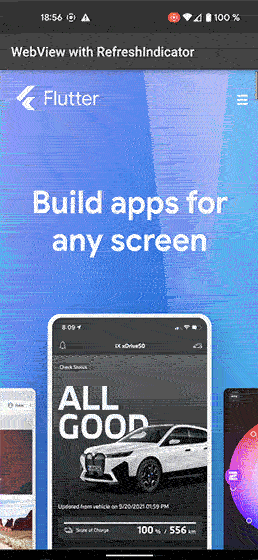Flutter Web Refresh
Pull down to refresh WebView Page in flutter with RefreshIndicator.
Tested with webview_flutter : ^4.4.2.
Getting Started
A simple working solution of pull down to refresh WebView page with RefreshIndicator and without
SingleChildScrollView which causes issues with the WebView page scroll behavior of the rendered sites:
This version resolves following issues w/o SingleChildScrollView:
SingleChildScrollViewhas always the absolute height of the page e.g. if a text box was not expanded from the beginning (javascript), the scroll height exceeds the page height.- The WebView gets the whole scroll area height, but doesn't know the display size, so if a bottom or top modal sheet appears, they are not rendered correctly in the view area of the screen but in the absolute complete height of the scroll area, so then you have to scroll e.g. 6000px up and down.
- The scroll position stays where you left somewhere in your previous absolute page height, if you browse further w/o a page refresh.
Constants
exceedsLoadingTime: Checks if loading time exceeds a maximum time (e.g. 3 seconds) to re-allow drag to refresh if page is still loading (Check pull_to_refresh.dart).REFRESH_DISTANCE_MIN: Calculates in pull_to_refresh.dart from the screen size the needed dragging distance to start the refresh process (default is0.2WebView screen pixels).
Update
I changed using ScrollNotification which RefreshIndicator interprets right when FixedScrollMetrics are set. So we have the original animation like in SingleChildScrollView or e.g. chrome browser.
Usage
Just use DragGesturePullToRefresh from my pull_to_refresh.dart like in my webview.dart example in yours (commented with // Here), that's it:
import 'package:flutter/foundation.dart';
import 'package:flutter/material.dart';
import 'package:flutter_web_refresh/pull_to_refresh.dart';
import 'package:webview_flutter/webview_flutter.dart';
class MyWebViewWidget extends StatefulWidget {
final String initialUrl;
const MyWebViewWidget({
Key? key,
required this.initialUrl,
}) : super(key: key);
@override
State<MyWebViewWidget> createState() => _MyWebViewWidgetState();
}
class _MyWebViewWidgetState extends State<MyWebViewWidget>
with WidgetsBindingObserver {
WebViewController _controller = WebViewController();
late DragGesturePullToRefresh dragGesturePullToRefresh; // Here
@override
void initState() {
super.initState();
dragGesturePullToRefresh = DragGesturePullToRefresh(); // Here
_controller = WebViewController()
..setJavaScriptMode(JavaScriptMode.unrestricted)
..enableZoom(true)
..setNavigationDelegate(
NavigationDelegate(
onPageStarted: (String url) {
// Don't allow RefreshIndicator if page is loading, but not needed
dragGesturePullToRefresh.started(); // Here
},
onPageFinished: (String url) {
// Hide RefreshIndicator for page reload if showing
dragGesturePullToRefresh.finished(); // Here
},
onWebResourceError: (WebResourceError error) {
//debugPrint('MyWebViewWidget:onWebResourceError(): ${error.description}');
// Hide RefreshIndicator for page reload if showing
dragGesturePullToRefresh.finished(); // Here
},
),
)
..loadRequest(Uri.parse(widget.initialUrl));
dragGesturePullToRefresh // Here
.setController(_controller)
.setDragHeightEnd(200)
.setDragStartYDiff(10)
.setWaitToRestart(3000);
//setState(() {});
WidgetsBinding.instance.addObserver(this);
}
@override
void dispose() {
// remove listener
WidgetsBinding.instance.removeObserver(this);
super.dispose();
}
@override
Widget build(context) {
return RefreshIndicator(
triggerMode: RefreshIndicatorTriggerMode.onEdge,
onRefresh: dragGesturePullToRefresh.refresh, // Here
child: Builder(
builder: (context) {
// IMPORTANT: Use the RefreshIndicator context!
dragGesturePullToRefresh.setContext(context); // Here
return WebViewWidget(
controller: _controller,
// Add it to the WebViewWidget
gestureRecognizers: {Factory(() => dragGesturePullToRefresh)}, // Here
);
},
),
);
}
}Differences w/o SingleChildScrollView or to e.g. the chrome browser
TheRefreshIndicatorshows no initial animation by dragging it down until the distance is reached to start the refresh process.The web page scrolling is not blocked, when you start to drag down from the top position of the page to start the refresh process, e.g. like in the chrome browser. So the refresh process is stopped if start to drag down from the page's top position and then up before reaching the distance to start the refresh process. Check the method inrefreshPage()in the pull_to_refresh.dart
Resources
- Original idea with updating height of SingleChildScrollView
- Idea for usind drag gesture recognizer
- Issue: flutter webview VerticalDragGestureRecognizer get no callback but only onDown and onCance
- [webview_flutter] added onPullToRefresh to the WebView()
- Unable to add pull to refresh functionality to the webview_flutter
